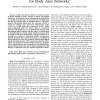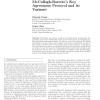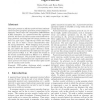144
click to vote
TITB
2010
14 years 7 months ago
2010
A Body Area Network (BAN) is a wireless network of health monitoring sensors designed to deliver personalized health-care. Securing inter-sensor communications within BANs is essen...
JCP
2007
15 years 27 days ago
2007
Abstract— Converting a secure group key agreement protocol into password-based setting is not a trivial task. The security of a password-based scheme hinges on preventing diction...
103
click to vote
IJSN
2007
15 years 27 days ago
2007
: McCullagh and Barreto presented an identity-based authenticated key agreement protocol in CT-RSA 2005. Their protocol was found to be vulnerable to a key-compromise impersonation...
118
click to vote
SCN
2008
Springer
15 years 28 days ago
2008
Springer
A new identity-based key agreement protocol designed to operate on thenetworklayerispresented. Endpoint addresses, namelyIP and MAC addresses, areusedaspublickeystoauthenticatethe ...
IPL
2006
15 years 29 days ago
2006
The Diffie-Hellman key agreement protocol is based on taking large powers of a generator of a prime-order cyclic group. Some generators allow faster exponentiation. We show that to...
114
Voted
IJNSEC
2006
15 years 1 months ago
2006
In 2004, Kim, Huh, Hwang and Lee proposed an efficient key agreement protocol for secure authentication. In this paper, we shall show that their proposed protocol cannot resist th...
IJNSEC
2006
15 years 1 months ago
2006
This paper presents an efficient password-based authenticated encrypted group key agreement protocol immune to dictionary attack under the computation Diffie-Hellman (CDH) assumpt...
120
click to vote
CJ
2007
15 years 1 months ago
2007
In this paper we show that the group key agreement protocol proposed by Tseng suffers from a number of serious security vulnerabilities.
106
click to vote
IJNSEC
2008
15 years 1 months ago
2008
For an identity-based authenticated key agreement (IDAK) protocol, PKG forward secrecy is the strongest notion of forward secrecy, which is about the security of previously establ...
120
Voted
SEC
2001
15 years 2 months ago
2001
Abstract Traditionally, research in secure group key agreement focuses on minimizing the computational overhead for cryptographic operations, and minimizing the communication overh...






